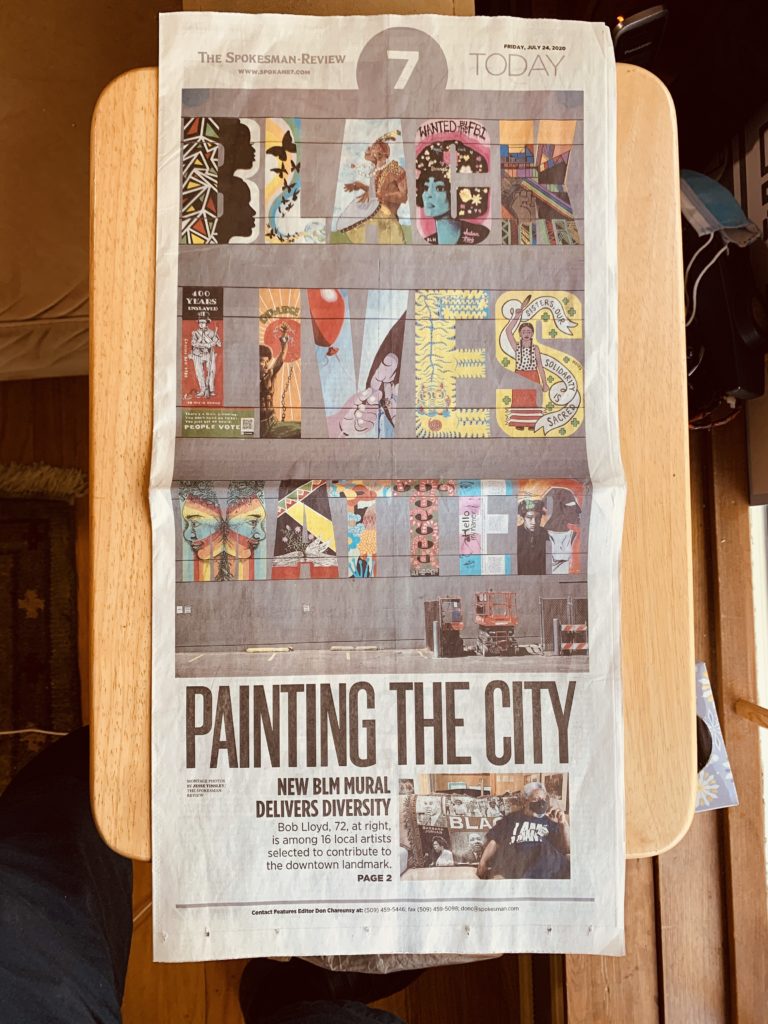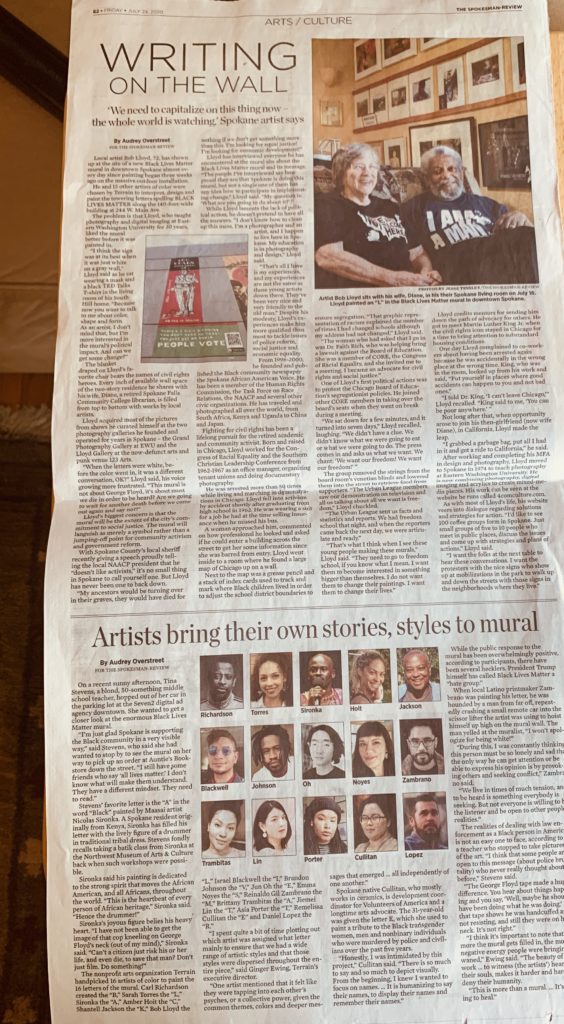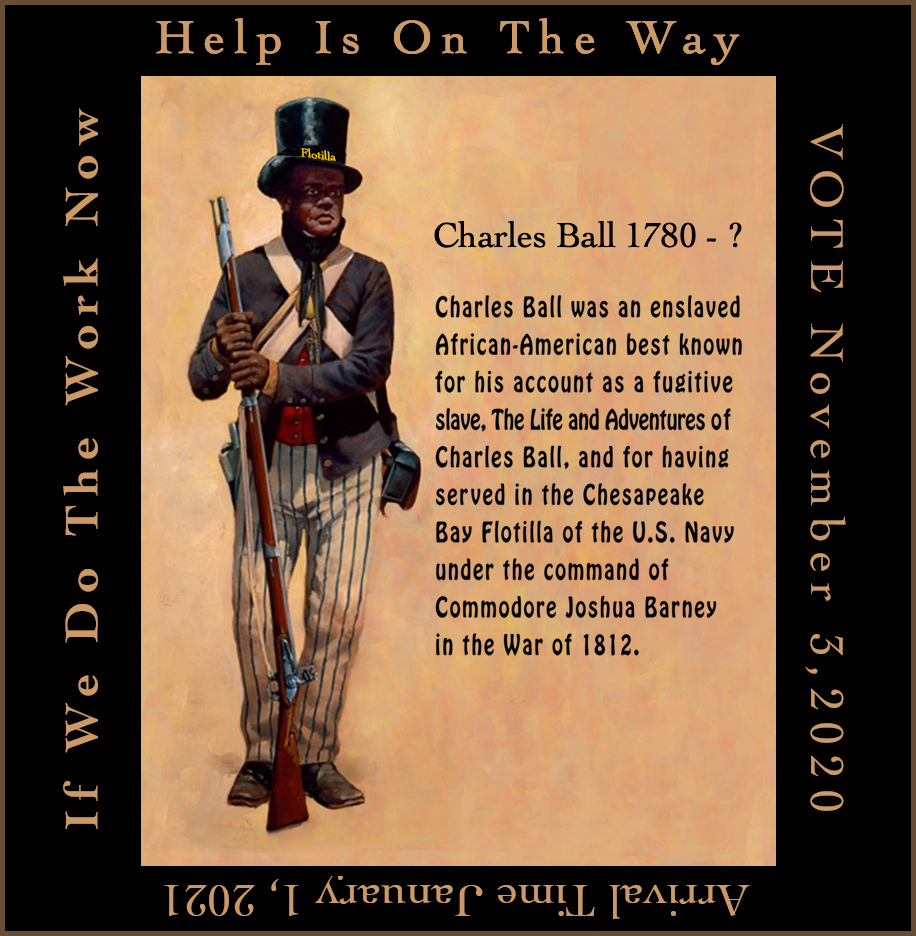This page will be updated with interviews of the artists and visitors to the mural.
Visit 4comculture.com to catch ongoing posts so you’ll find some answers to what you can do to be sure BLACK LIVES MATTER and to build the community you want to live in.
Bob L. would like to thank the Spokesman Review, journalist Audrey Overstreet and photographer Jesse Tinsley for this article in the Today section on Friday, July 24, 2020. Click the links below to go to the articles.
16 artists Scroll to the bottom of the feature photograph and tap on the thumbnails to enlarge.
Painting the City We need to capitalize on this thing now – the whole world is watching


The L in LIVES Was a Collaborative Effort
Robert Lloyd had the inspiration and designed the L in LIVES to speak to the continued marginalization of African Americans for over 400 years. He called upon Native American artist Jacob Johns and his indispensable talent and attention to detail in this collaboration as they painted it on the wall. He is looking forward to seeing murals by Jacob Johns as well as the other 15 artists of color involved in this project.
CHARLES BALL 50 Years A Slave

LIFE IN SLAVERY
Charles Ball was born as a slave in the same county around 1781. He was about four years old, when his owner died. To settle the debts, his mother, several brothers and sisters and he himself were sold to different buyers. His first childhood memory recorded in the book is his being brutally separated from his mother by her buyer: “Young as I was, the horrors of that day sank deeply into my heart, and even at this time, though half a century has elapsed, the terrors of the scene return with painful vividness upon my memory.”
By way of inheritance, sale and even as a result of a lawsuit, he is passed on to various slaveholders. From January 1, 1798 to January 1, 1800 he is hired out to serve as a cook on the frigate USS Congress. In 1800, he marries Judah. In 1805, when his eldest son is 4 years old, he is sold to a South Carolinian cotton planter, thus separated from his wife and children who had to remain in Maryland.
In September 1806, he is given as a present to the newly wedded daughter of his owner and has to relocate to Georgia to a new plantation. Shortly afterwards, after the sudden death of the new husband, the new plantation, together with the slaves, including him, is rent out to yet another slaveholder, with whom he builds up a relationship of mutual trust. He becomes the headman on the new plantation, but suffers from the hatred of his master’s wife. In 1809, when his dying master is already too weak to interfere, he is cruelly whipped by that woman and her brother. After that, he plans his escape, which he puts into practice after his master’s death. Travelling by night to avoid the patrols, using the stars and his obviously excellent memory for orientation, suffering terribly from hunger and cold, not daring to speak to anybody, he returns to his wife and children in early 1810.
WAR OF 1812 CHESAPEAKE FLOTILLA SERVICE
Charles Ball also served in the U.S. Navy during the War of 1812. In 1813, Ball had enlisted in Commodore Joshua Barney’s Chesapeake Bay Flotilla and fought at the Battle of Bladensburg on August 24, 1814. An excerpt from his account of the battle, which was a resounding defeat for the Americans:
“I stood at my gun, until the Commodore was shot down, when he ordered us to retreat, as I was told by the officer who commanded our gun. If the militia regiments, that lay upon our right and left, could have been brought to charge the British, in close fight, as they crossed the bridge, we should have killed or taken the whole of them in a short time; but the militia ran like sheep chased by dogs.”
LIFE AFTER THE WAR
In 1816, his wife Judah died. Ball married a second time, Lucy, and was able to buy a small farm from money he had earned and saved. In 1830, he is traced down by the man who whipped him 21 years earlier, kidnapped and again taken to Georgia. He escapes again to learn that Lucy and the children have been kidnapped into slavery and his farm been taken by a white man. Because he legally still is a slave, he is not able to claim his rights, but has to relocate to Pennsylvania where he wrote his 1837 memoir, with the help of the white lawyer Isaac Fisher.
Nothing is known of his later fate, nor of that of his wife or children.
From Charles Ball Wikipedia
ONLINE TEXT OF “Slavery in the United States: A Narrative of the Life and Adventures of Charles Ball, a Black Man, Who Lived Forty Years in Maryland, South Carolina and Georgia, as a Slave Under Various Masters, and was One Year in the Navy with Commodore Barney, During the Late War.”,
